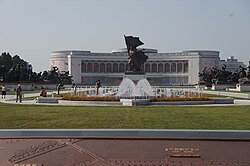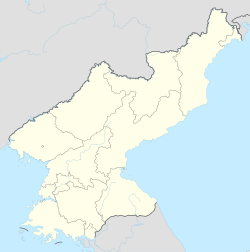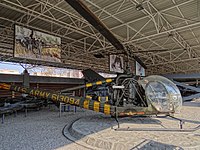
A cruiser is a type of warship. Modern cruisers are generally the largest ships in a fleet after aircraft carriers and amphibious assault ships, and can usually perform several operational roles from search-and-destroy to ocean escort to sea denial.

The Type A Ko-hyoteki class was a class of Japanese midget submarines (Kō-hyōteki) used during World War II. They had hull numbers but no names. For simplicity, they are most often referred to by the hull number of the mother submarine. Thus, the midget carried by I-16-class submarine was known as I-16's boat, or "I-16tou."
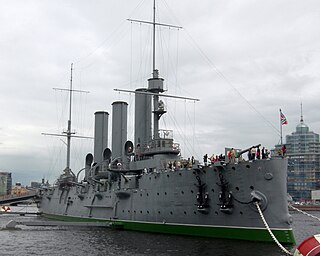
A museum ship, also called a memorial ship, is a ship that has been preserved and converted into a museum open to the public for educational or memorial purposes. Some are also used for training and recruitment purposes, mostly for the small number of museum ships that are still operational and thus capable of regular movement.

USS Baltimore (CA-68) was the lead ship of her class of heavy cruiser, the fifth ship of the United States Navy named after the city of Baltimore, Maryland.

USS Pueblo (AGER-2) is a Banner-class environmental research ship, placed into service during World War II, then converted to a spy ship in 1967 by the United States Navy. She gathered intelligence and oceanographic information, monitoring electronic and radio signals from North Korea. On 23 January 1968, the ship was attacked and captured by a North Korean vessel, in what became known as the "Pueblo incident", or alternatively, as the "Pueblo crisis".

USS Canberra (CA-70/CAG-2) was a Baltimore-class cruiser and later a Boston-class guided missile cruiser of the United States Navy (USN). Originally to be named USS Pittsburgh, the ship was renamed before launch to honor the Australian cruiser HMAS Canberra sunk during the Battle of Savo Island. Canberra was the first USN warship named after a foreign capital city, and one of the few named after a foreign warship not captured in battle with a USN ship.

The Taedong River (Korean: 대동강) is a large river in North Korea. The river rises in the Rangrim Mountains of the country's north where it then flows southwest into Korea Bay at Namp'o. In between, it runs through the country's capital, Pyongyang. Along the river are landmarks such as the Juche Tower and Kim Il-sung Square.
The names of commissioned ships of the United States Navy all start with USS, for United States Ship. Non-commissioned, primarily civilian-crewed vessels of the U.S. Navy under the Military Sealift Command have names that begin with USNS, standing for United States Naval Ship. A letter-based hull classification symbol is used to designate a vessel's type. The names of ships are selected by the Secretary of the Navy. The names are those of states, cities, towns, important persons, important locations, famous battles, fish, and ideals. Usually, different types of ships have names originated from different types of sources.

HMAS Canberra (I33/D33), named after the Australian capital city of Canberra, was a Royal Australian Navy (RAN) heavy cruiser of the Kent sub-class of County-class cruisers. Constructed in Scotland during the mid-1920s, the ship was commissioned in 1928, and spent the first part of her career primarily operating in Australian waters, with some deployments to the China Station.
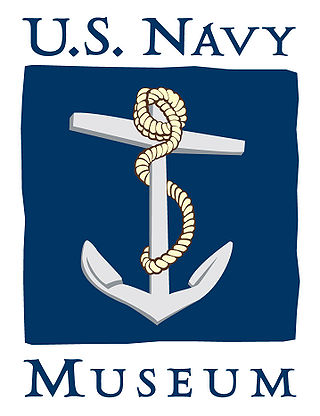
The National Museum of the United States Navy, or U.S. Navy Museum for short, is the flagship museum of the United States Navy and is located in the former Breech Mechanism Shop of the old Naval Gun Factory on the grounds of the Washington Navy Yard in Washington, D.C., United States.

The history of the Korean People's Army Naval Force is short compared to most modern navies. It began with the creation of a "Maritime Security Force" on June 5, 1946. The headquarters for the force was based in the North Korean city of Wonsan, and was operational by July 1946. The headquarters were then expanded and moved to the capital, Pyongyang, for more effective management of seabound traffic, and the forces were renamed Marine Patrols in December of the same year. The Marine Patrol Academy was established in Wonsan in June 1947 in order to train and commission a professional corps of naval officers.

The Battle of Chumonchin Chan or the action of 2 July 1950 was fought between surface combatants during the main phase of the Korean War. It began after an Allied flotilla encountered a Korean People's Navy supply fleet.

The Battle of Dogger Bank on 10 February 1916 was a naval engagement between the Kaiserliche Marine of the German Empire and the Royal Navy of the United Kingdom, during the First World War. Three German torpedo boat flotillas sortied into the North Sea and encountered the British 10th Sloop Flotilla near Dogger Bank. The German vessels eventually engaged the British vessels, after mistaking them for cruisers instead of minesweeping sloops. Knowing they were out-gunned, the British attempted to flee and in the chase, the sloop HMS Arabis was sunk, before the British squadron escaped. As the cruisers of the Harwich Force returned to port, the light cruiser HMS Arethusa struck a mine, ran aground and broke in two. Although the Germans were victorious, they inflated the victory by reporting that they had sunk two cruisers.
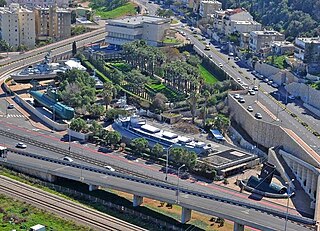
The Clandestine Immigration and Naval Museum is a technical history museum located in Haifa, Israel.
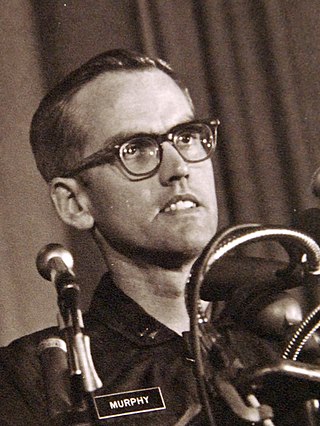
Edward R. Murphy is a former United States Navy officer, best known as the executive officer aboard the USS Pueblo (AGER-2), a spy ship captured by North Korea in 1968.

The Banner class was a class of three environmental research ships converted from Camano-class cargo ships by the United States Navy during the 1960s. The class comprised three ships: Banner, Pueblo, and Palm Beach. The ships were originally United States Army vessels, which had been built in 1944. Although officially classified as environmental research ships, they were actually used for signals intelligence gathering, as part of the AGER program.

The Monument to the Victorious Fatherland Liberation War is an outdoor monument in Pyongyang, North Korea. The monument is outside of the Victorious Fatherland Liberation War Museum. The monument itself is a series of statues depicting soldiers of the various branches of the Korean People's Army. The central statue of the collection is known as the Victory Statue and it depicts a soldier of the KPA raising the flag of North Korea. The monument was completed in 1993 to mark the 40th anniversary of the end of the Korean War. This includes side monuments titled "Defenders of Altitude 1211", "Liberated south Korea", "Heroes of Wolmido", "Moving the Artillery Gun Up", Peoples' Reinforcement Frontline", "Defenders of Airspace of the Fatherland", War of Liberation of Taejon", Defenders of the Fatherland's Maritime", "Battle of Nakdong River", and "Combat of the Peoples' Guerllia Force". Moored on a nearby bank of the Taedong River is the captured United States Navy spy ship the USS Pueblo.
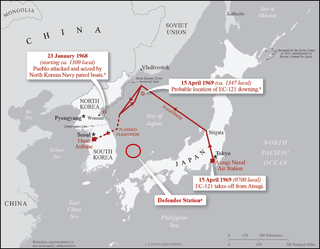
Operation Formation Star was the code name for the emergency re-deployment of U.S. Seventh Fleet warships to the Sea of Japan off the eastern coast of North Korea following that country's seizure of the USS Pueblo (AGER-2) in international waters on 23 January 1968.
